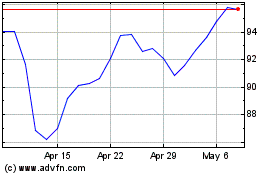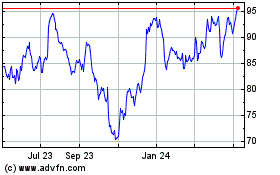Morgan Stanley's Wealth Unit Yields Stability for Bank
July 20 2016 - 1:04PM
Dow Jones News
By Anna Prior
Morgan Stanley's wealth-management unit muted the effects of
volatile markets on revenue during the second quarter, as the bank
continues to position the business for profitability and growth as
investment advice increasingly goes digital.
Revenue for the New York bank's wealth-management arm in the
latest quarter slipped $64 million, or about 2%, from the
year-earlier period to $3.81 billion. The unit saw lower
commissions and asset-management fees, which fell 14% to $423
million and 4% to $2.08 billion, respectively.
However, net interest income increased by $92 million, or 12%,
to $829 million as loans to wealth-management clients grew 19% to a
record $69 billion.
"Even though we haven't seen a pickup in retail engagement, [the
wealth-management] business continues to provide stability against
an uncertain macro backdrop," Chief Financial Officer Jonathan
Pruzan said during a conference call Wednesday to discuss
earnings.
Profit in Morgan Stanley's wealth arm fell roughly 8% to $516
million from last year, but lower expenses helped pretax profit
margin improve from 21% in the first quarter to 23% in the latest
quarter. Chief Executive James Gorman previously said the bank has
targeted pretax margin for the unit of 23% to 25% for 2017.
Overall, Morgan Stanley reported a 12% decline in second-quarter
profit but still topped analysts' subdued expectations.
Among other items Morgan Stanley reported along with
second-quarter earnings, the bank said its brokerage arm kept its
work force basically flat at 15,909.
"Attrition is clearly running low and it's been like that for a
while," Mr. Pruzan said on the call. Mr. Gorman added that the
Department of Labor's new retirement-advice rule, which toughens
standards for financial advisers and brokers providing advice on
retirement accounts, hasn't affected recruitment.
Annualized revenue per broker fell about 2% from last year to
$959,000.
Morgan Stanley's brokerage had $12 billion in inflows to
fee-based accounts. That helped increase fee-based assets by about
$22 billion from the first quarter to $820 billion, which
represents about 40% of Morgan Stanley's $2 trillion in client
assets.
Meanwhile, the unit is exploring the intersection of technology
and investment advice, as executives emphasized the firm's
investment in digital initiatives during a discussion of the bank's
earnings call.
"Digital is far more than just robo," Mr. Pruzan said on the
call. "We think that the right business model and the winning hand
here is a combination of advice and [financial advisers] with
technology."
The unit's digital strategy, he added, has focused on three main
areas including data and analytics, efficiencies around automation,
and the various platforms on which clients interact with advisers
and the firm.
Traditional wealth-management and brokerage firms have been
wrestling with how best to embrace the fast-growing digital
investment-advice segment, typically referred to as "robo
advisers."
Wells Fargo & Co.'s brokerage and retirement arm has
announced it may soon offer its own robo adviser, while UBS Group
AG's U.S. brokerage said in May that it is teaming up with a robo
adviser to develop new tools for its brokers.
Morgan Stanley executives didn't discuss any specific robo
offerings on Wednesday, but noted the bank has been "investing
heavily in this area."
"We believe secular trends are for advice with technology, and
that's the business that we are building," Mr. Pruzan said.
Write to Anna Prior at anna.prior@wsj.com
(END) Dow Jones Newswires
July 20, 2016 12:49 ET (16:49 GMT)
Copyright (c) 2016 Dow Jones & Company, Inc.
Morgan Stanley (NYSE:MS)
Historical Stock Chart
From Mar 2024 to Apr 2024

Morgan Stanley (NYSE:MS)
Historical Stock Chart
From Apr 2023 to Apr 2024
